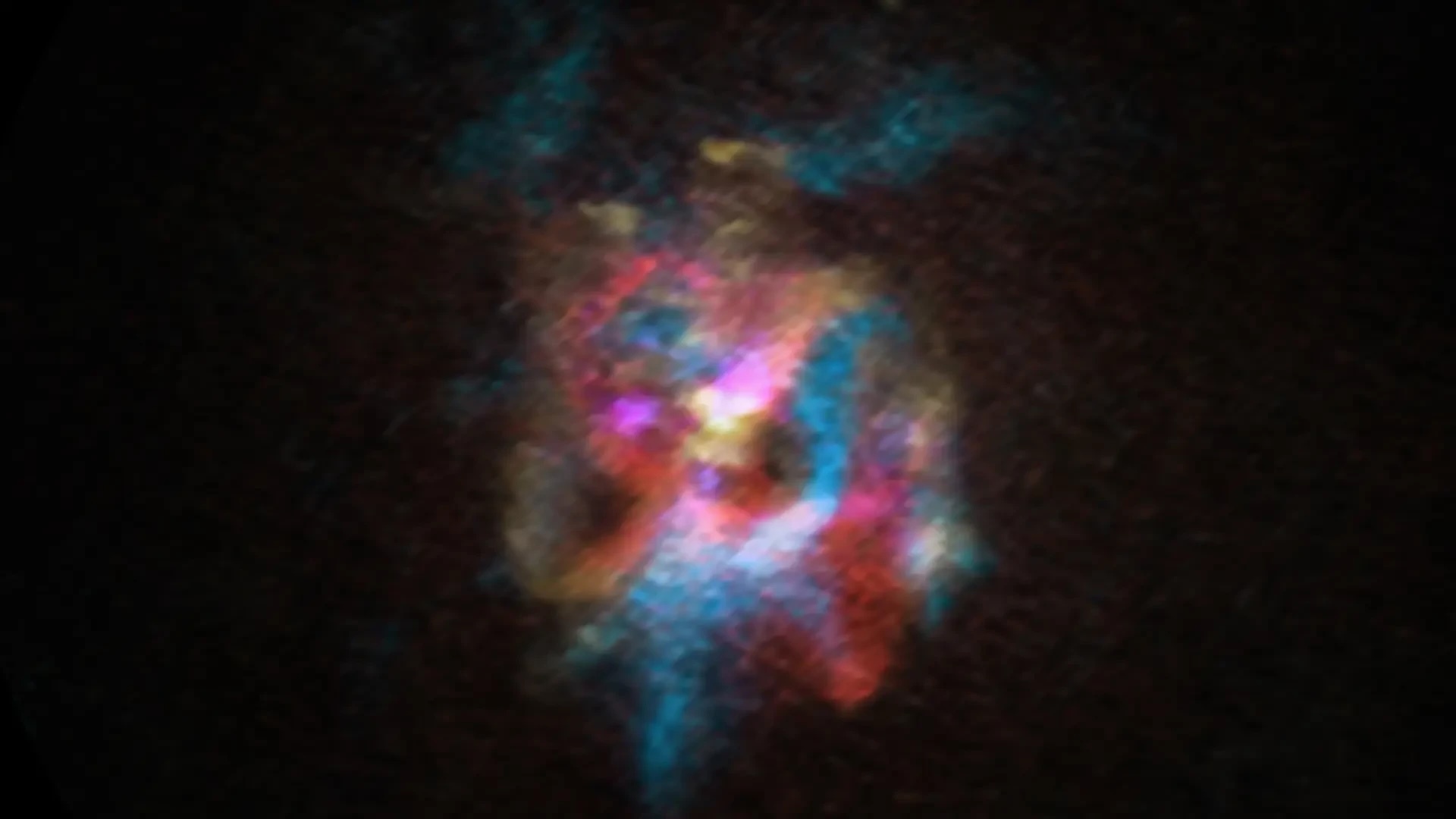22.08.2025

The vast bubble around red supergiant star DFK 52, imaged by Alma. Red colours indicate gas moving away from us, blue denotes gas moving toward us. Credit: ALMA(ESO/NAOJ/NRAO)/M. Siebert et al.
Astronomers have discovered a vast and expanding bubble of gas and dust surrounding a red supergiant star – the largest structure of its kind ever seen in the Milky Way. The bubble, which contains as much mass as the Sun, was blown out in a mysterious stellar eruption around 4000 years ago. Why the star survived such a powerful event is a puzzle, scientists say.
The results are published in the scientific journal Astronomy and Astrophysics, and the research team was led by Mark Siebert, Chalmers University of Technology. Using the ALMA radio telescope in Chile, the researchers observed the star DFK 52 – a red supergiant similar to the well-known star Betelgeuse.
“We got a big surprise when we saw what ALMA was showing us. The star is more or less a twin of Betelgeuse, but it’s surrounded by a vast, messy bubble of material,” says Mark Siebert at Chalmers.
The bubble, a complex of clouds of gas and dust, weighs as much as the Sun, and extends out 1.4 light years from the star. That’s thousands of times wider than our own solar system.
If the star was as close to us as Betelgeuse is, the bubble would appear to span a third of the full Moon’s width in the sky.
ALMA’s radio observations let astronomers measure the motion of molecules in the cloud, revealing that the bubble is expanding. They believe it was formed when the star suddenly ejected part of its outer layers in a powerful explosion just a few thousand years ago.
“The bubble is made of material that used to be part of the star. It must have been ejected in a dramatic event, an explosion, that happened about four thousand years ago. In cosmic terms, that’s just a moment ago,” says Elvire De Beck, astronomer at Chalmers.
The galaxy's next supernova?
Why DFK 52 shed so much mass without exploding as a supernova is still unclear. One possibility is that the star has a hidden companion that helped it eject its outer layers.
“To us, it’s a mystery as to how the star managed to expel so much material in such a short timeframe. Maybe, like Betelgeuse seems to, it has a companion star that’s still to be discovered," says Mark Siebert.
Red supergiants like DFK 52 are nearing the ends of their lives and are expected to eventually explode as supernovae. Could this star be next?
“We’re planning more observations to understand what’s happening – and to find out whether this might be the Milky Way’s next supernova. If this is a typical red supergiant, it could explode sometime in the next million years,” says Elvire De Beck.

Photographer: NASA/JPL-Caltech/IPAC
Images
A (top): Red supergiant DFK 52 and its surroundings seen by ALMA. The vast, complex bubble blown by this extreme star is about 1.4 light years across, tens of thousands of times wider than our Solar System. Alma measures light invisible to our eyes, with wavelength around 1.3 millimetres, emitted by molecules of carbon monoxide and silicon monoxide. Thanks to the Doppler effect, the team has measured how fast the gas is moving along our sightline towards the star. In this image, parts of the bubble moving away from us relative to the star are shown in red, and material moving towards us in blue.
Credit: ALMA(ESO/NAOJ/NRAO)/M. Siebert et al.
B: Red supergiant star DFK 52 is a member of the star cluster Stephenson 2. In this image, the brightest stars are all supergiants, and all members of the cluster. This image is made from data taken with the Spitzer Space Telescope in light much redder than our eyes can see (wavelengths 3.6, 4.5, 5.8 and 8 micrometres). Despite its remarkable bubble, too small to see in this image, DFK 52 is not unusually bright. The bright star in the lower left is another red supergiant, known as DFK 1 or Stephenson 2-18. It may be one of the largest stars known.
Credit: NASA/JPL-Caltech/IPAC
More about the research
The image was featured as ESO’s Picture of the Week on 4 August 2025
The research is presented in the paper: "Stephenson 2 DFK 52: Discovery of an exotic red supergiant in the massive stellar cluster RSGC2" (link to pdf version), which is accepted for publication in the journal Astronomy and Astrophysics.
The researchers involved in the study are Mark Siebert (Chalmers), Elvire De Beck (Chalmers), Guillermo Quintana Lacaci (Instituto de Fisica Fundamental, Madrid, Spain) and Wouter Vlemmings (Chalmers).
Red supergiants are some of the rarest, brightest stars in the sky. They are the final stage of evolution of stars born much more massive than the Sun (more than eight times the Sun’s mass). For astronomers, they are keys to understanding the life stories of all stars and planets. The most massive stars create and spread newly-formed elements throughout interstellar space, energising gas and dust, and helping new generations of stars to form.
The closest red supergiants in our galaxy, the Milky Way, are easily visible for anyone with a clear view of a dark night sky. Betelgeuse, in the constellation Orion, and Antares, in Scorpius, are both well-known examples of red supergiant stars.
More about the ALMA telescope
The Atacama Large Millimeter/submillimeter Array (ALMA), an international astronomy facility in Chile, is a partnership of ESO, the U.S. National Science Foundation (NSF) and the National Institutes of Natural Sciences (NINS) of Japan in cooperation with the Republic of Chile. ALMA is funded by ESO on behalf of its Member States, by NSF in cooperation with the National Research Council of Canada (NRC) and the National Science and Technology Council (NSTC) in Taiwan and by NINS in cooperation with the Academia Sinica (AS) in Taiwan and the Korea Astronomy and Space Science Institute (KASI)
ALMA construction and operations are led by ESO on behalf of its Member States; by the National Radio Astronomy Observatory (NRAO), managed by Associated Universities, Inc. (AUI), on behalf of North America; and by the National Astronomical Observatory of Japan (NAOJ) on behalf of East Asia. The Joint ALMA Observatory (JAO) provides the unified leadership and management of the construction, commissioning and operation of ALMA.
In Sweden, Chalmers University of Technology and Onsala Space Observatory have been involved in ALMA since its inception; receivers for the telescope are one of many contributions. Onsala Space Observatory is host to the Nordic ALMA Regional Centre, which provides technical expertise to the ALMA project and supports astronomers in the Nordic countries in using ALMA.
Quelle: Chalmers University of Technology
